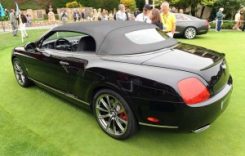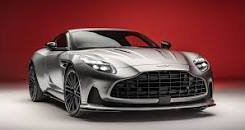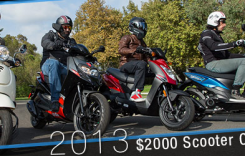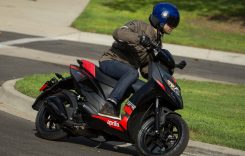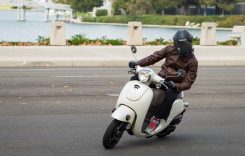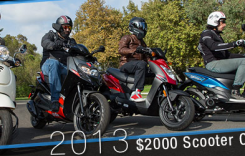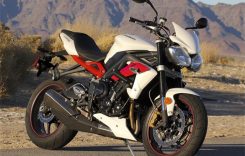Suzuki proves that a quality motorcycle doesn’t have to max your credit card limit with its affordable and air-cooled TU250X ($4399). Pairing timeless lines to a small but efficient, electric-start equipped 249cc Single the lightweight TU is a true example of a little bike that can.
Simple and clean, the Suzuki is a cute-looking classic. We especially like its uncluttered appearance from nose to tail. But when viewed against the tuxedo-dressed Royal Enfield or the smart looking SR the TU appears basic, showing up to cocktail hour in flip-flops and a white-T. Still if you’re seeking that simple, no frills look the Suzuki certainly fits the bill.

“It’s a beautiful bike,” says Ana, the resident fashion expert. “Just look at this beauty—it’s gorgeous.”
Slide into the Suzuki’s short 30.3-inch saddle however and you’ll be impressed by its level of craftsmanship. It’s head and shoulders above the $1600 more expensive Indian-built Continental and on a level consistent with its price point versus the $1591 more premium Yamaha. Another plus is how light it is weighing only 320 pounds with a full tank of gas. That’s 52 pounds less than the SR and 90 pounds fewer than the Royal Enfield.
“Great seat—very comfortable. I am a little tall for this bike so when I was sitting on it my knees came a little bit high but otherwise great,” explains Ana of the TU’s more compact and shorter rider-friendly ergonomics.
Thumb the starter button and the Suzuki’s engine comes right to life every time. Some might bemoan that there’s no kickstarter, but stall the SR in traffic and you’ll quickly forget about that gripe. Although the gauge pod is missing a tachometer, it’s not a deal breaker since it’s easy to read the engine and base shift points on feel and sound.
On the road the tiny TU offers the nimbleness of a scooter. It shines when ridden through narrow crisscrossing city streets and busy parking lots. But on the flip side, the chassis is the least composed at higher speeds through corners. Still, considering its intended application, the Suzuki gets the job done just fine. Also of note is the stronger, more sensation-rich front brake helping it to achieve the shortest stopping distance from 60 mph (152.3 feet).
At highway speeds, the engine’s more limited lung capacity hurt it requiring the rider to make more carefully planned overtaking maneuvers.
“It needs a little more power,” explains Ana of the Suzuki’s tiny 249cc Single. “You can feel it even just going uphill. You really need to pin-it to go anywhere—sorry Suzuki [laughs]. Otherwise it’s very smooth and the suspension is great. The only thing for me is a little bit more power. The rest I loved it.”
(Top) At higher speeds the Suzuki’s chassis lacks the road holding of the more firmly damped Royal Enfield. (Center) The Suzuki’s front brake offers the most lever sensation during braking helping it achieve the shortest stopping distance from 60 mph. (Bottom) The Suzuki offers the maneuverability of a scooter through town. It’s a choice motorcycle for riding across narrow and crowded streets.
“The Suzuki felt a little like riding a scooter power-wise,” Melissa admits. “It didn’t’t go and in traffic it was frustrating because if you tried to dart around a car or something like that, you just can’t. So you couldn’t’t take gaps in traffic as easily on it.”
Results of dyno testing help demonstrate the TU’s power deficiency. It produces less than half the torque of the Continental GT (12.12 vs. 28.12 lb-ft) and 7.82 lb-ft less than the 150cc-larger SR. However, measuring rear wheel horsepower the discrepancy wasn’t as large with it giving up between six and seven ponies against its rivals.
Still the Suzuki performed better than expected in the acceleration tests. Although a little slow off the line, requiring 11.8 seconds to giddy-up to 60 mph, through the quarter mile the TU was only a second off the Royal Enfield and 1.5 seconds behind the SR. Contrary to the more torquey GT and SR, the Suzuki responds best when shifted at high rpm. And since there’s no tachometer, your ears tune into the harmonics of the engine—making sure upshifts are timed exactly right. It’s a fun little game and one that’s aided by the precise action of its five-speed transmission.
True, the Suzuki’s engine lacks the charisma of the tractor-like Royal Enfield, yet it is a little more entertaining to ride than the SR’s—as long as you’re not afraid of playing the aforementioned high-rpm shifting game. In sound testing, the 250 tied the SR (for the most quiet) with a decibel figure that was one point softer at idle, but one louder at riding speed.
While the Suzuki’s engine comes up a little short in acceleration it more than makes up for it in fuel mileage recording the highest miles-per-gallon figure of 62.9. Factor in the 3.2-gallon capacity of it fuel tank (same as the Yamaha) and the TU is capable of an over 200-mile range on a single fill-up.
“I don’t have any complaint except that it was kind of boring to me,” sums up Melissa. “It didn’t’t do anything poorly but it didn’t’t do anything really well and seemed a little ho-hum.”
